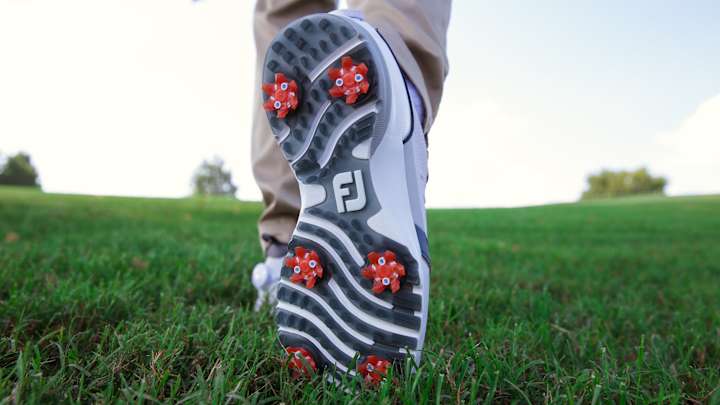Independent golf shoe study: distance vs. comfort

Six yards.
What would you do to drive a golf ball off the tee 6 yards farther in the air? Would you wear golf shoes with spikes instead of golf shoes without spikes?
That’s not a trick question, but the answer might surprise you. Many amateur golfers who participated in an independent study conducted at Pinehurst Resort said they would give up 6 yards, which is about what the higher-handicappers gained in the tests when wearing spikes, in favor of more comfortable shoes that don’t have cleats.
"I don’t think anybody came in thinking, I won’t hit it farther with spikes," said Eric Alpenfels, Pinehurst Resort’s director of instruction and golf academy. "We'd show them the numbers when they were done and a lot of them said, 'That's all right, I still like the comfort.' I was a little surprised."
I get it. If you’re walking 18 holes every day on a flat, firm course and never playing in wet conditions, spikeless shoes may feel better on your feet. I travel with spikeless shoes when I go to professional tournaments for work. They're good for spectating on the course or if I get a chance to sneak in a round or two myself, and I'm less likely to trip in the clubhouse or media center than if I wore spikes that might snag on carpeting.
I also don’t get it. I used to play in amateur competitions and I’d never consider teeing it up without wearing spikes. I just feel more grounded and more in control.

Plus, now I'm that guy in the aging golf demographic who is starting to lose distance. I can’t afford to give up another 6 yards. You'll have to pry those golf spikes out of my cold, dead hands.
Alpenfels and Dr. Bob Christina, emeritus professor of kinesiology at the University of North Carolina at Greensboro, ran a pair of studies to examine the benefits of spikes versus spikeless.
In the first one, they tested 28 male golfers, all volunteers, hitting drivers. Half were better players with handicaps ranging from plus-3 to 9, the other half had handicaps between 13 and 20. The site was the Pinehurst Golf Academy, one of the country’s best ranges. It features mowing patterns that offer defined fairways, so driving accuracy can also be measured. The study was commissioned by PrideSports, which makes a variety of sporting goods that include Champ and SoftSpikes golf cleats.
"I assumed there would be a difference, but I was interested to see how much of a difference,” Alpenfels said. “I thought clubhead speed would be the significant thing to change but it was more the Smash Factor.”
Smash Factor is the ball speed divided by the clubhead speed. The low handicappers in the study gained about 2.6 yards of carry per drive when wearing spikes (262.7 yards) versus no spikes (260.1). The higher handicappers picked up 6 yards, 198.3 with spikes versus 192.2 without spikes.
Alpenfels said he expected a substantial change in clubhead speed when players changed shoes to go without spikes but that was not the case. There was almost no difference. The Smash Factor was better with spikes. Lower handicappers saw a .006 improvement while higher handicappers increased by .018. Those numbers sound tiny but factored into the energy transfer from the clubhead to the ball, they are significant.
>Which type shoe do you prefer?
The driver study, held in 2019, found no big differences in driving accuracy, swing path, clubhead path or launch angle when players wore different shoes.
“The players did a little better with spikes and had tighter dispersions of their shots,” Alpenfels said. “The feedback we got was even though they did better with spikes, the four or six extra yards wasn’t enough to make up for the difference in comfort. Some of these guys walk our No. 4 course, which has waste areas and sand and the clay will clump in your spikes at times. So they like spikeless so they’re not always banging that stuff off their shoes. But they’ll wear spikes if they’re playing in a cart. I heard a lot of different strategies from guys about which shoe they wore. But the vast majority of responses were that people felt they had more connection to the ground when wearing spikes.”
In February, Alpenfels and Christina set up a sequel, this time with players hitting 6-iron shots from a level lie and from a downhill lie with a slope of 8 to 10 degrees.
The results were similar. Both handicap groups missed the target line significantly less while wearing spikes from a level lie. The average carry distance was longest when shots were hit from a level lie while wearing spikes and worst when not wearing spikes on a downhill lie.
The lower handicappers gained 3.7 yards with spikes on a level lie and 2.8 yards on a downhill lie while the higher handicappers picked up 1.8 yards and 5.2 yards, respectively.
The Smash Factors were better for players wearing spikes, just as in the driver test, because ball speed increased while clubhead speed stayed the same. Lower handicappers gained 1.0 mph of ball speed wearing spikes on a level lie and 0.5 mph on a downhill lie while higher handicappers increased 1.3 mph and 1.9, respectively.
“Reflecting back, the clubhead speeds didn’t go up like we thought they would,” Alpenfels said. “The Smash Factor did. When you have something affect both groups the same way, that’s a pretty big deal. You’ve got to get any advantage you can. We didn’t change anything except add spikes on their shoes and the higher handicaps gained six yards of carry with their drivers. That was the appealing thing to me.”
So should you wear spikes or go spikeless? Do you want comfort or do you want to gain maybe 6 yards of carry on your drive? It’s up to you.
I’ll take the 6 yards, thank you very much.
Sign up to receive the Morning Read newsletter, along with Where To Golf Next and The Equipment Insider.
